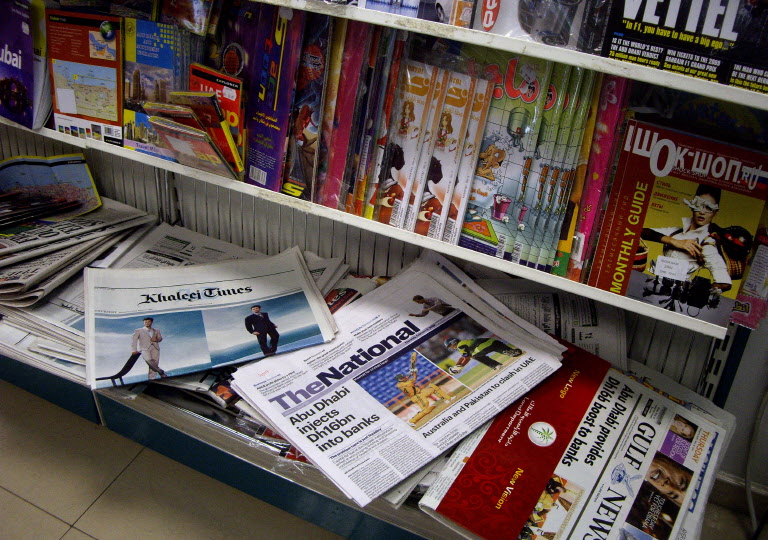Dubai, UAE – MENA region newspaper and magazine revenues have fallen every year since 2018, from a high of US$2 billion in 2018 to US$1.4 billion in 2022, a 30 percent drop, according to the latest research by Strategy& Middle East, part of the PwC network, in collaboration with Google.
The analysis also forecasts a compound annual growth rate (CAGR) of -4% up to 2027, which could cause total MENA revenues to fall even further to US$1.2 billion. The figures also show that while digital advertising revenues are slowly increasing at a rate of 1% per year, print advertising revenues are set to slump by 11.3% by 2027.
“The rapid changes in the news media industry in the MENA region have created real avenues for growth. To successfully capitalize on these opportunities, news organizations will need to digitally transform, adopt sustainable business models, and pursue operational agility, innovation, and productivity,” said Karim Sarkis, Partner at Strategy&, part of the PwC network, and the leader of the media and entertainment sector in the Middle East.
The report, entitled ‘Building a Vibrant News Industry in the Middle East and North Africa,’ analyzed three of the largest news markets in MENA – Egypt, Saudi Arabia, and the UAE – which together account for 80 percent of advertising spending in the region’s entertainment and media industry. The survey of 4,500 consumers shows that the shift away from direct consumption from the news media, particularly among younger cohorts, has also created a major financial challenge for traditional news organizations, eroding their revenues.
The transformation in MENA consumers’ news consumption habits is driven by factors such as widespread mobile connectivity, high internet penetration, and social media usage, particularly among young, tech-savvy consumers. In terms of news formats, 66% of respondents named mobile video as their favorite for news consumption. Short-form articles were also popular, enjoyed by 58% of respondents.
Social media
About 68% percent of MENA consumers have identified social media as their primary news source, emphasizing a significant shift in the way people are consuming news, the survey revealed.
Aligned with this trend, 90% of respondents also indicated their mobile phone as their preferred device for accessing news.
Opportunities for growth
The report argues that MENA news organizations should revamp their business models and content delivery methods, focusing on new content types, formats, and digital engagement. Notably, 45% of respondents indicated a willingness to pay for high-quality reporting, especially for popular categories like entertainment, health, and sports.
“For more than 20 years, Google has been working collaboratively with news publishers around the world to help address the industry’s toughest challenges and create new opportunities. We’re equally committed to supporting a healthy news ecosystem in the Middle East and North Africa that drives value for consumers, creators, and news publishers,” said Mazen Sabbagh, News and Publishing Partnerships Lead with Google MENA. “The research by Strategy& underpins the need for the MENA region’s news industry to evolve fast and to focus its efforts on developing ways to better engage with news consumers and a strategic approach to diversifying its revenues and business models,” he added.
As part of the growth opportunity identified in the analysis, advertising revenues in the MENA region are expected to grow at a CAGR of 6% between 2022 and 2027 — compared with 4.5% globally. However, traditional news business models have limited growth prospects; between 2022 and 2027, newspaper and magazine revenues in the MENA region are forecast to drop by a compound annual growth rate of 4%. Notably, digital ad spending in MENA has significant room for growth, accounting for 79 percent of the $7.6 billion total ad spend in 2022. It is also expected to outstrip global growth by 2027, with a 6.9% rise — compared to 6.5% globally.
Generational divide

The way in which news outlets engage with consumers must, however, be nuanced and tailored to specific demographics. Although 61% of MENA respondents have increased their news consumption in the past three years, the frequency of news consumption varies widely by age. In particular, the report finds that younger consumers, especially between 18 and 24, access news less frequently than those older than 45 who access it every day. This constitutes a large and mostly untapped audience, because the MENA region has one of the youngest populations globally; 54% of its residents are under the age of 30.
If MENA region news media players are to capture these opportunities, new strategies and close collaboration among all relevant stakeholders will be required to modernize and strengthen the ecosystem. Specifically, the report highlights the need to achieve three objectives: (1) digital transformation, (2) an updated enabling environment, and (3) a reliable and trustworthy news ecosystem.
Karim Daoud, Partner with Strategy& Middle East, part of the PwC network, added: “A thriving news media industry relies on a supportive, updated enabling environment involving all stakeholders in its modernization efforts. By working together, stakeholders can support the development of a talent pool for news organizations, offer the necessary financial support to the industry, provide access to the required infrastructure and innovative technologies, and establish up-to-date policies and regulations.”
“Governments in the MENA region, as well as regulators, global tech platforms, advertisers, and academia need to support news organizations through talent development programs, targeted financial support, media literacy initiatives for consumers, and an updated regulatory framework,” the study highlighted. “More initiatives are also needed to bolster and modernize the technological infrastructure. In particular, the implementation of cloud solutions, AI, and machine learning tools can increase operational efficiencies for news organizations, as well as quality of reporting, and enhance consumer engagement.”








